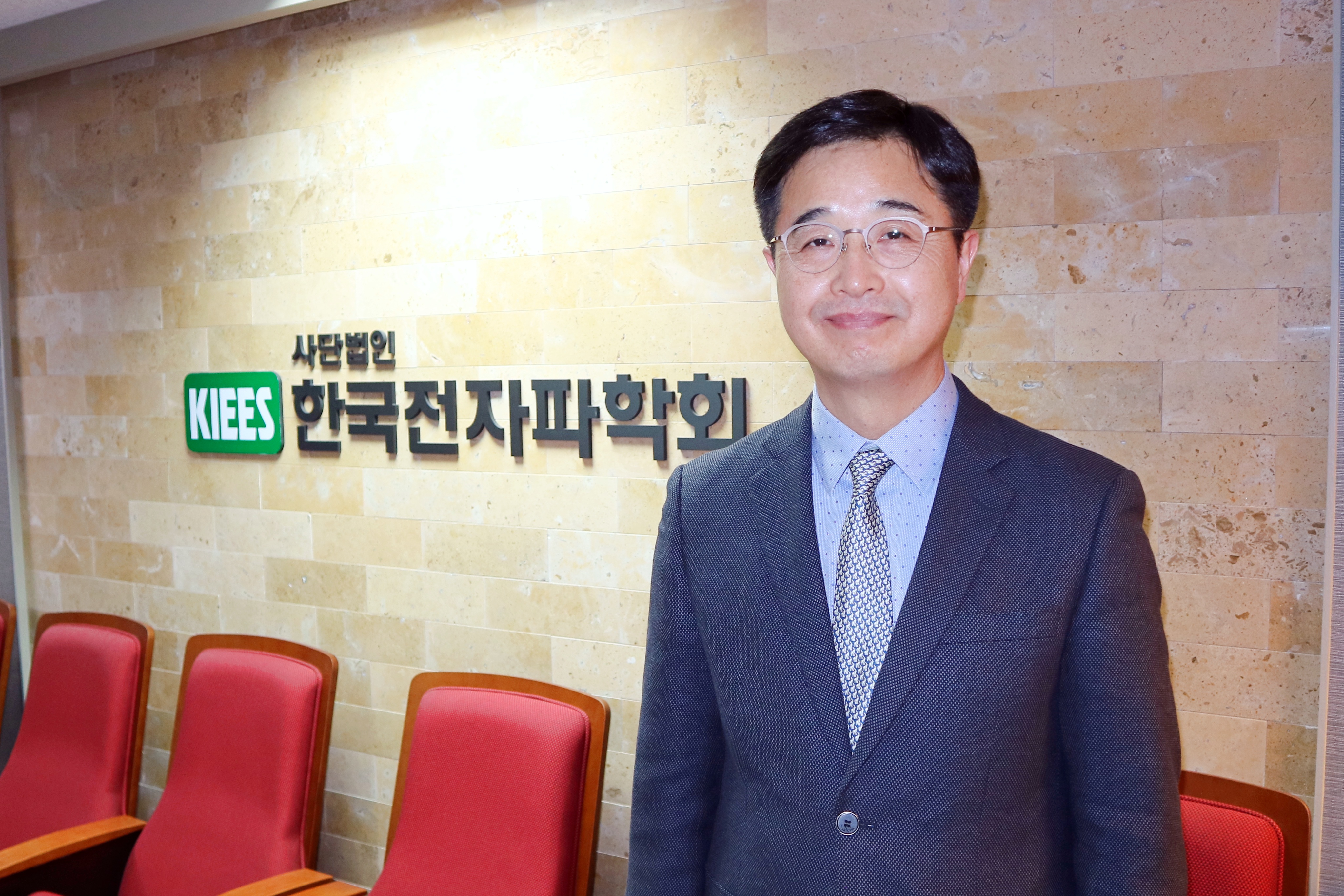[편집자주] 글로벌 경제 위기 속에서 2023년 새해가 밝았다. 산업과 기술 패권 경쟁이 날로 치열해지는 가운데 차세대 기술 개발에 국가의 사활이 달려 있다고 해도 과언이 아닐 것이다. 위기 극복의 단초가 될 엄중한 시기, 국내 전자파 분야 기술 과학의 산실 한국전자파학회 25대 회장으로 임명된 육종관 신임회장을 만나 이야기를 나눠봤다.
“전자파, 인체 신경망·혈관 역할 인프라”
전자파 기술, 우주·국방 분야 핵심
사이버 전자기전 영역 확장 도모
EMC 전문가 양성 위한 투자 必
[편집자주] 글로벌 경제 위기 속에서 2023년 새해가 밝았다. 산업과 기술 패권 경쟁이 날로 치열해지는 가운데 차세대 기술 개발에 국가의 사활이 달려 있다고 해도 과언이 아닐 것이다. 위기 극복의 단초가 될 엄중한 시기, 국내 전자파 분야 기술 과학의 산실 한국전자파학회 25대 회장으로 취임한 육종관 신임회장을 만나 이야기를 나눠봤다.
육종관 신임회장은 학회 비전과 운영 방향성, 기술 발전의 미래 전망과 기술 전문가 양성에 대해 전문가의 시선으로 통찰력 있는 견해를 밝혔다. 그를 통해 지상 인프라를 넘어서 우주로 뻗어 나가는 전자파 기술의 미래를 엿볼 수 있었다.

▲한국전자파학회 25대 회장 육종관 연세대학교 전기전자공학부 교수
■ 자기소개 부탁드린다
연세대학교 전기전자공학부 교수로 재직 중이며 이번에 한국전자파학회 25대 회장직을 맡게 됐다.
연구분야는 전자파 수치해석 분야이며, 주로 EMI/EMC나 초고주파 회로 및 바이오센서, 국방 스텔스 기술 등의 연구하고 있다.
1999년에 학회 활동을 본격적으로 시작해서 EMC기술연구회, 전자파보안 연구회 등을 중심으로 활동했으며, 영문지편집 상임이사, 총무상임이사 등을 거치며 지금껏 학회의 일에 봉사하고 있다.
■ 한국전자파학회에 대해서 간단히 소개 부탁드린다
한국전자파학회는 1989년 창립했고, 전자파 및 ICT 분야의 대표적인 학회로 성장해 왔습니다. 현재 12,000여명의 회원이 있으며, 1,000여명 이상이 참여하는 하계 및 동계종합학술대회를 매년 개최하고 있다.
또한 산하의 20여개 연구회가 활발히 활동하며, 산학연 그리고 관 및 군을 포함한 전문가들과 활발한 교류를 벌이고 있다.
■ 올해 신임회장으로서 학회를 이끌어갈 텐데 학회 운영의 방향성과 비전은 어떻게 설명했는가?
올해는 전반적으로 경제가 어렵다는 예측들이 참으로 많다. 그래서 올 한 해 학회 및 회원들의 외적 성장보다는 내적 성장에 초점을 두고 싶다.
특히 학계 및 산업체 등에서 헌신하고 있는 젊은 연구자들을 발굴하고 그들의 학술활동을 격려하고 지원할 생각이다. 또한 다양한 기회를 통해 회원들의 국제적 활동을 지원하고 장려할 계획이다.
최근에는 우주 및 국방 분야에도 전자파 관련 기술들이 핵심적인 기여를 하고 있기 때문에 이 분야에서 그리고 사이버전자기전 등의 분야에서 학회의 전문 분야를 넓혀 나갈 계획이다.
■ 2023년 새해, 학회가 주요하게 집중할 산업분야와 아젠다는 무엇인가?
앞에서도 짧게 언급했지만, 올해는 우주 및 국방 분야의 △전자파 기술 △스텔스 기술 △고출력 전자파 기술 △전자파 보안기술 △사이버 영역과 전자파 기술이 융합된 사이버전자기전 기술 등의 분야로 연구 및 교류를 더 활성화시키고 싶다. 또한 최근 유행하고 있는 우주 및 6G 통신 분야에도 학회가 관심을 가지고 기여할 부분이 있는지 살펴볼 예정이다.
전자파 관련 기술은 인프라 기술이라서 눈에 잘 보이지는 않는다. 하지만 인체의 신경망이나 혈관과 같은 역할을 전자파 기술이 맡고 있다. 따라서 우리 학회는 산업 발전과 국가경쟁력의 핵심이 되는 전자파기술 발전을 위해 △인력 양성 △학술 교류 △전자파 관련 정책 개발 등에 적극적으로 기여할 생각이다.
■ 무선전력전송, 커넥티드 모빌리티, 5G 솔루션 등 전자파분야와 관련된 산업의 중요성이 해를 거듭할수록 높아지고 있다. 다가올 2023년 어떤 전자파 분야가 뜨겁게 불타오를지 예측해 보신다면?
미래를 예측하는 것은 사람의 영역은 아니다. 신의 영역이지만, 조심스레 전망해본다면 전자파 기술이 녹아 들어간 다양한 융합기술 및 서비스가 계속 등장할 것이라 생각한다.
예를 들면 5G 및 6G 통신 분야에서는 △회로와 안테나가 통합된 기술 △intelligent surface 기술 등이 많이 각광을 받을 것 같다.
국방분야에서는 △multi-static 레이다 △전자기 스펙트럼 기술 △위성 및 무인기 기반 SAR 기술 △고출력 전자파 기술 등이 고도화될 것이라 생각한다. 특히 저궤도 위성 사업이 성공하기 위한 통신기술 및 네트워킹 기술들이 굉장히 중요한데 이 분야에 대한 많은 연구와 큰 발전이 있을 것으로 예상한다.
■ 앞서 언급한 분야들이 떠오를수록 EMI/EMC 문제도 함께 거론될 거란 생각이 든다. 각종 표준·인증과 더불어 내성 설계 등에 대응할 전자파 전문가 양성에 대해 현재 수준을 진단한다면 어떻게 보는지, 그리고 향후 대비할 점은 없는지 전문가 의견이 궁금하다
EMI/EMC 분야는 특히 개별 부품레벨의 기술을 뛰어넘어서 시스템 레벨의 지식과 경험이 필요한 분야이기 때문에, 전문가 양성에 많은 시간과 노력이 필요하다.
반면 국내에서는 이 분야의 전문가 양성이나 교육이 상당히 등한시되었던 것도 사실이다. 정부 차원에서 중소기업 지원을 위한 정책의 일환으로 약 20여년 전에 ‘EMC기술지원센터’ 설립했고 지금은 전자파기술원으로 이름이 바꿔서 약 20년째 운영하고 있다.
이를 통해 중소산업체의 EMC 관련 기술은 어느정도 지원이 가능하지만, 조직적이고 체계적인 고급연구 및 개발 인력 양성에는 전혀 미치지 못하고 있다. 향후 정부 및 산업체, 그리고 학계에서도 전자파 분야의 전문가 양성을 위한 노력과 투자가 필요하다고 생각한다.
■ e4ds news 독자분들께 2023년 새해 인사 간단히 부탁드린다
요즘은 정론직필(正論直筆)하는 언론사를 찾아보기 참 어려운 시대이다. 이러한 엄혹한 시절에 e4ds news는 언론의 책임과 의무를 다하고자 하는 모범적인 언론사라고 생각한다. e4ds를 통해 전자분야의 정확한 최신의 정보들을 얻고, 2023년 한 해도 더욱 성장하시길 기원한다.
감사합니다.